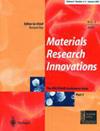Materials for Wearable Sensors
Q2 Engineering
引用次数: 1
Abstract
Wearable sensors are the technology of the future and will become an integral part of daily life. These sensors can monitor the physical activities and biochemical information of an individual, organ functions, and environmental changes. A wearable sensor may comprise a sensing element, electrodes, substrate, power unit and data processing unit. Selectivity, sensitivity and reliability of a wearable sensor depend on the sensing element, electrodes and substrate, which can be designed/fabricated with a suitable material. A variety of materials including carbon materials, conductive polymers, metal oxides, metals, elastomers, and nanomaterials have been used depending on the applications of the sensor. In this review, we will summarize the recent developments regarding the use of advanced materials for applications in wearable sensor technologies.可穿戴传感器材料
可穿戴传感器是未来的技术,将成为日常生活中不可或缺的一部分。这些传感器可以监测个人的身体活动和生化信息、器官功能和环境变化。可穿戴传感器可包括传感元件、电极、衬底、功率单元和数据处理单元。可穿戴传感器的选择性、灵敏度和可靠性取决于传感元件、电极和衬底,它们可以用合适的材料设计/制造。根据传感器的应用,各种材料,包括碳材料、导电聚合物、金属氧化物、金属、弹性体和纳米材料已经被使用。在这篇综述中,我们将总结关于使用先进材料在可穿戴传感器技术中的应用的最新进展。
本文章由计算机程序翻译,如有差异,请以英文原文为准。
求助全文
约1分钟内获得全文
求助全文
来源期刊

Materials Research Innovations
工程技术-材料科学:综合
CiteScore
5.20
自引率
0.00%
发文量
38
审稿时长
2.8 months
期刊介绍:
Materials Research Innovations covers all areas of materials research with a particular interest in synthesis, processing, and properties from the nanoscale to the microscale to the bulk. Coverage includes all classes of material – ceramics, metals, and polymers; semiconductors and other functional materials; organic and inorganic materials – alone or in combination as composites. Innovation in composition and processing to impart special properties to bulk materials and coatings, and for innovative applications in technology, represents a strong focus. The journal attempts to balance enduring themes of science and engineering with the innovation provided by such areas of research activity.
 求助内容:
求助内容: 应助结果提醒方式:
应助结果提醒方式:


